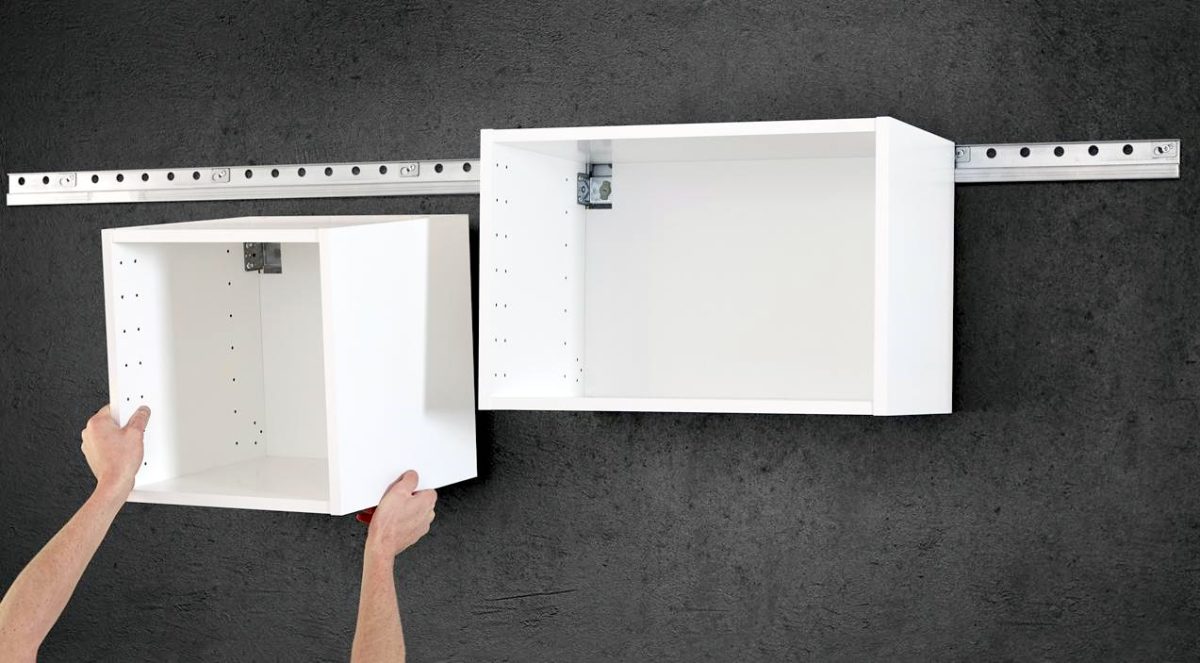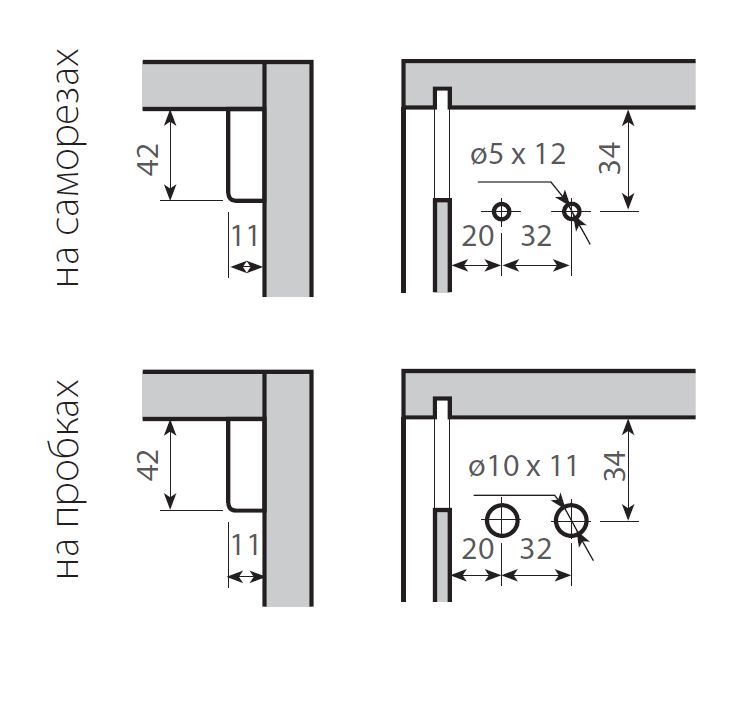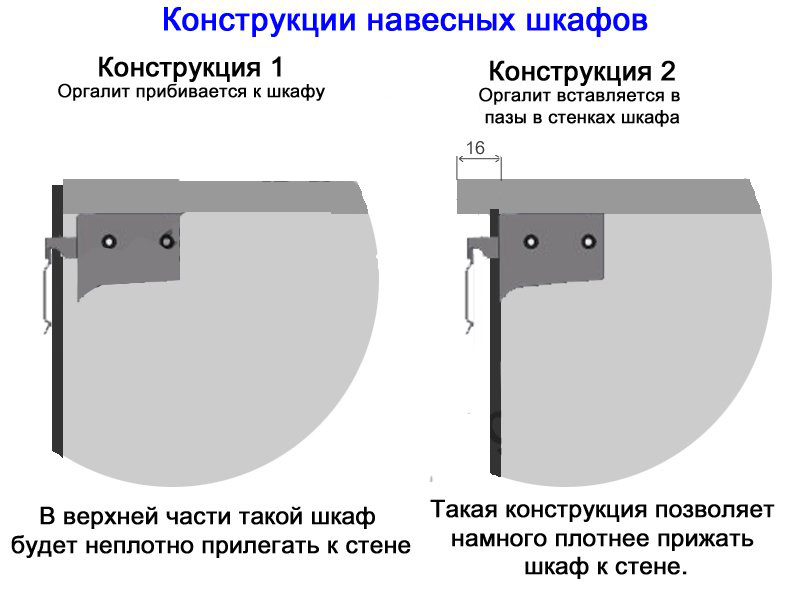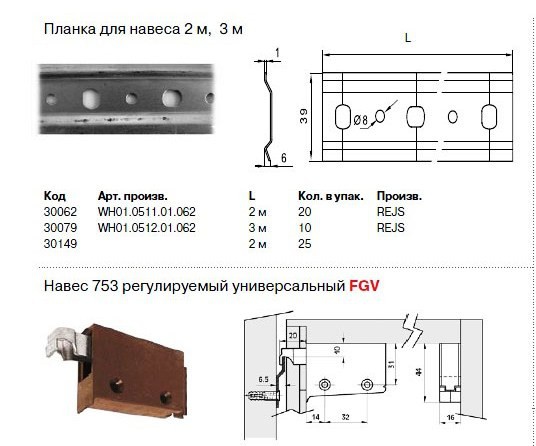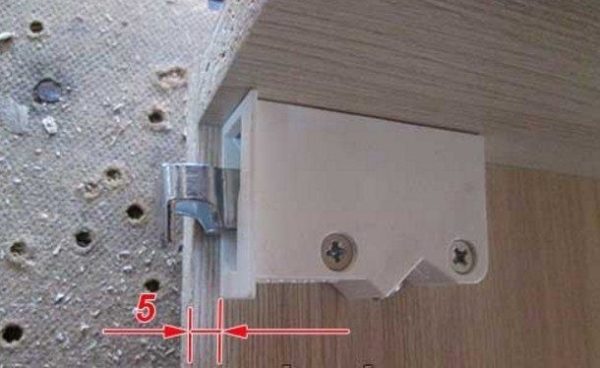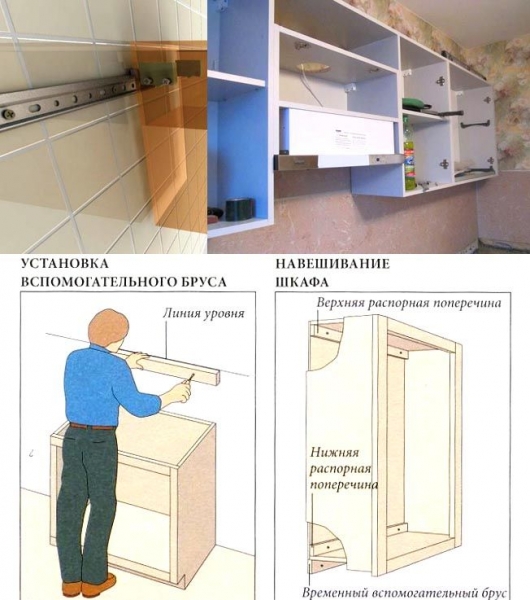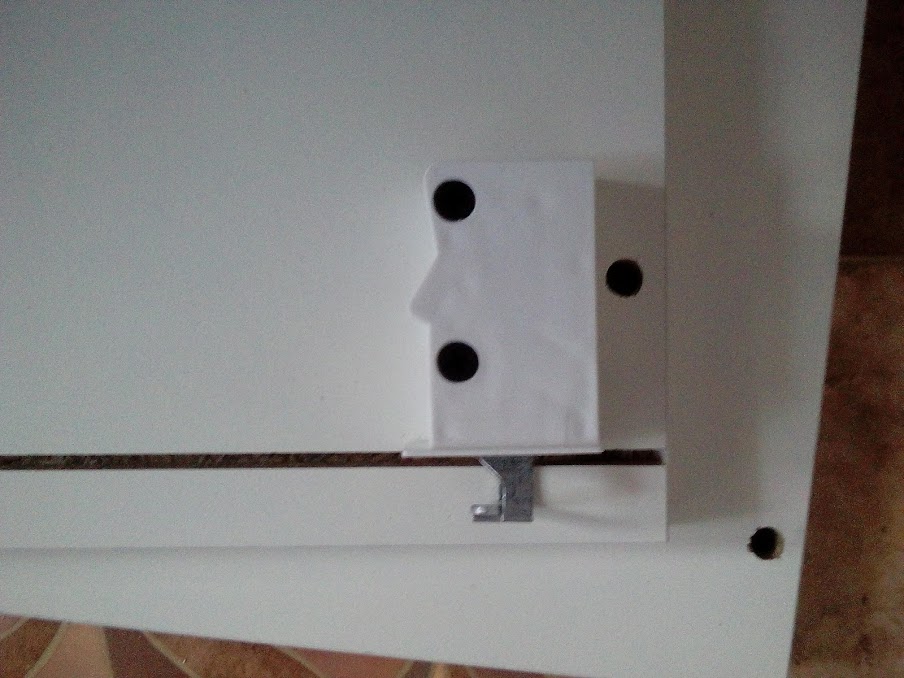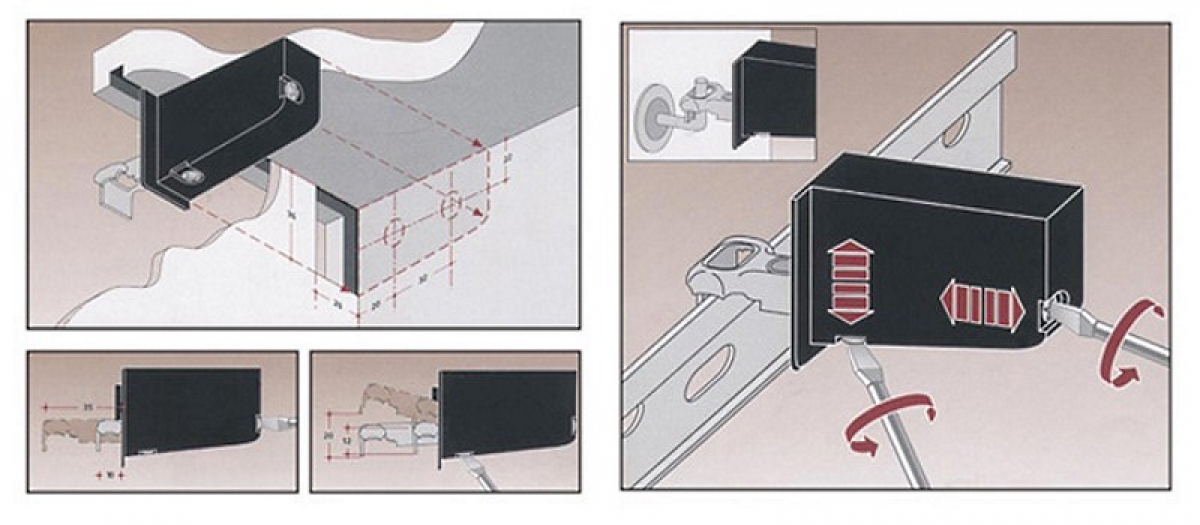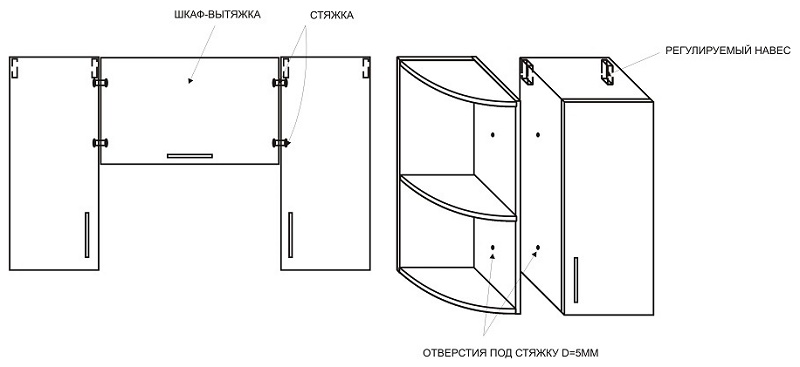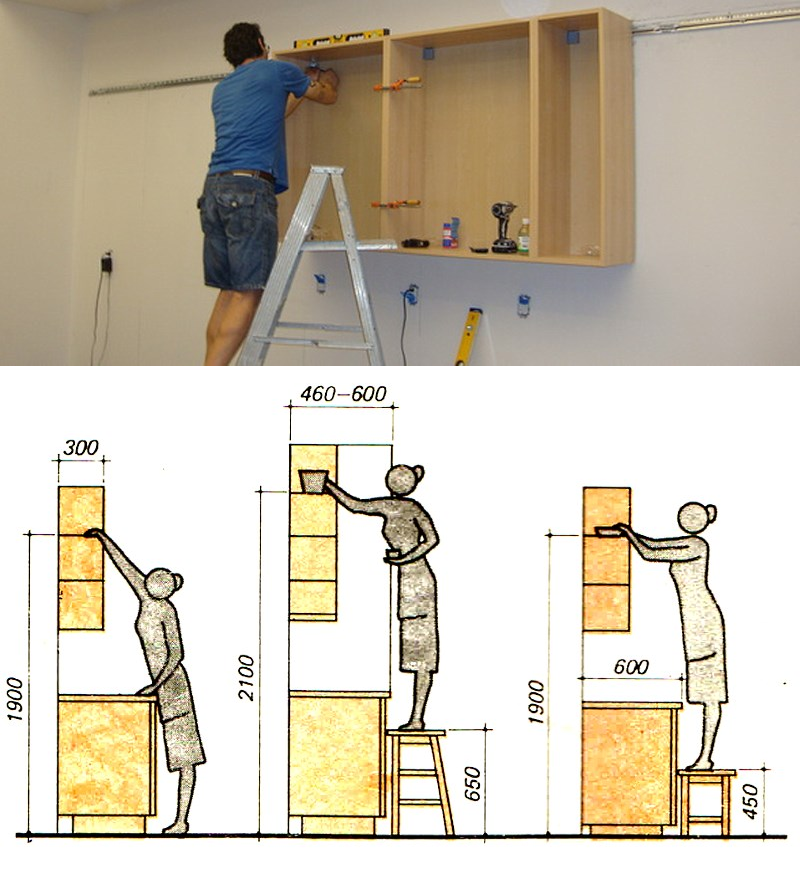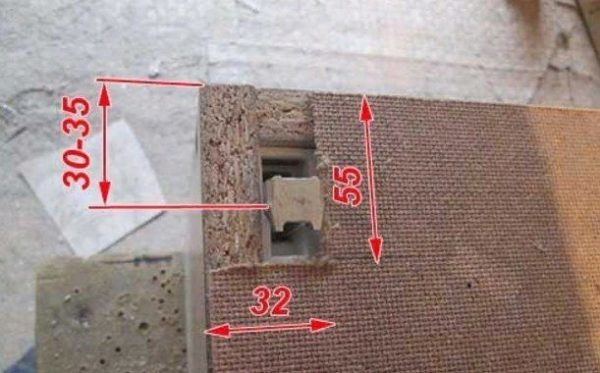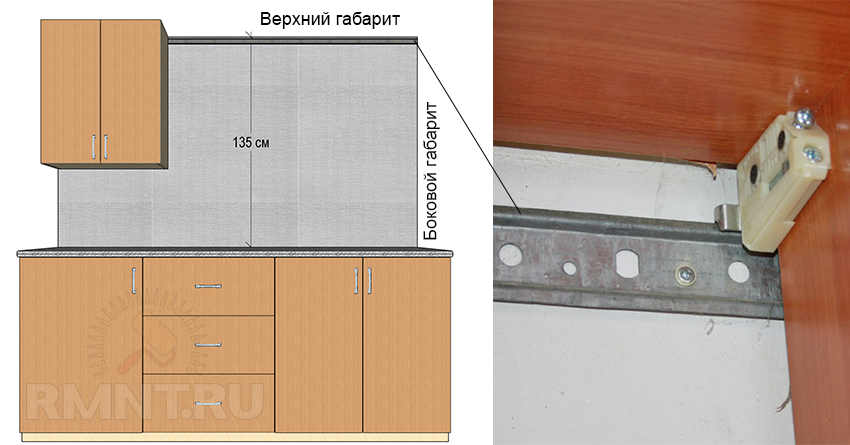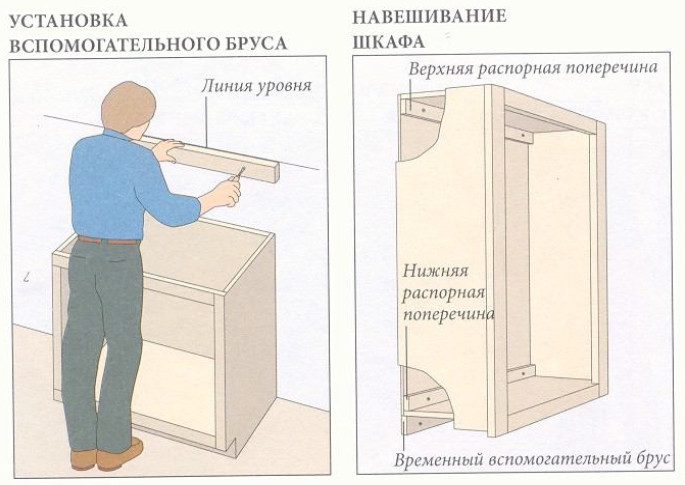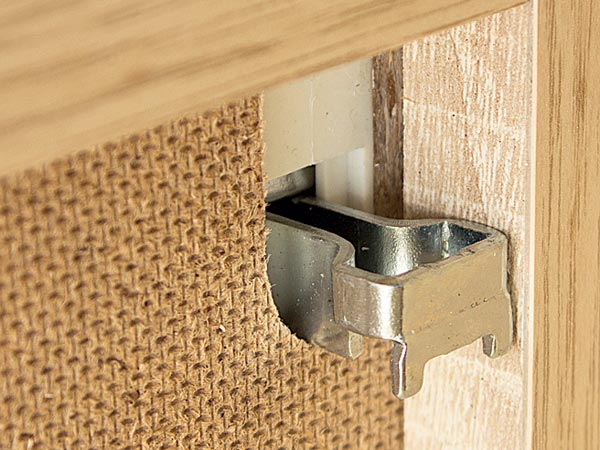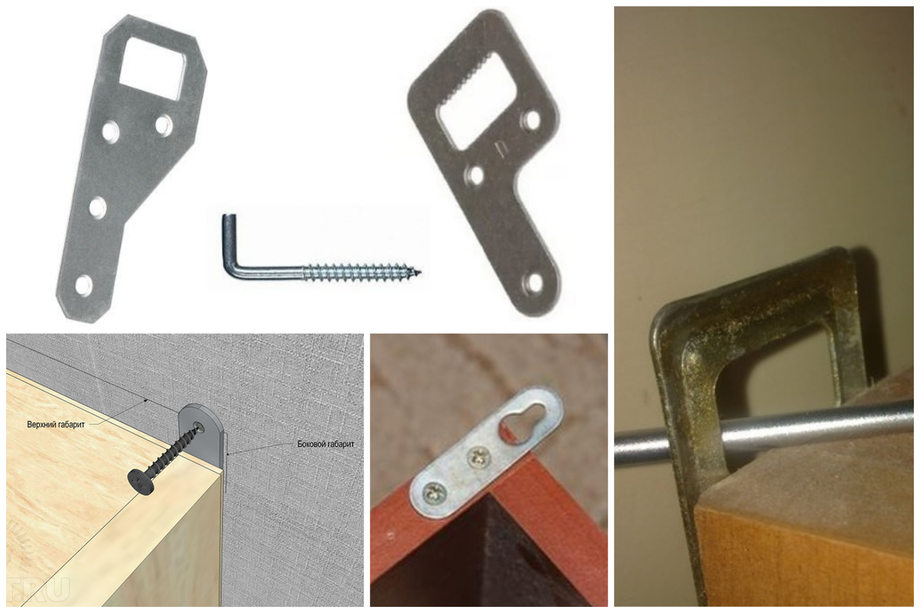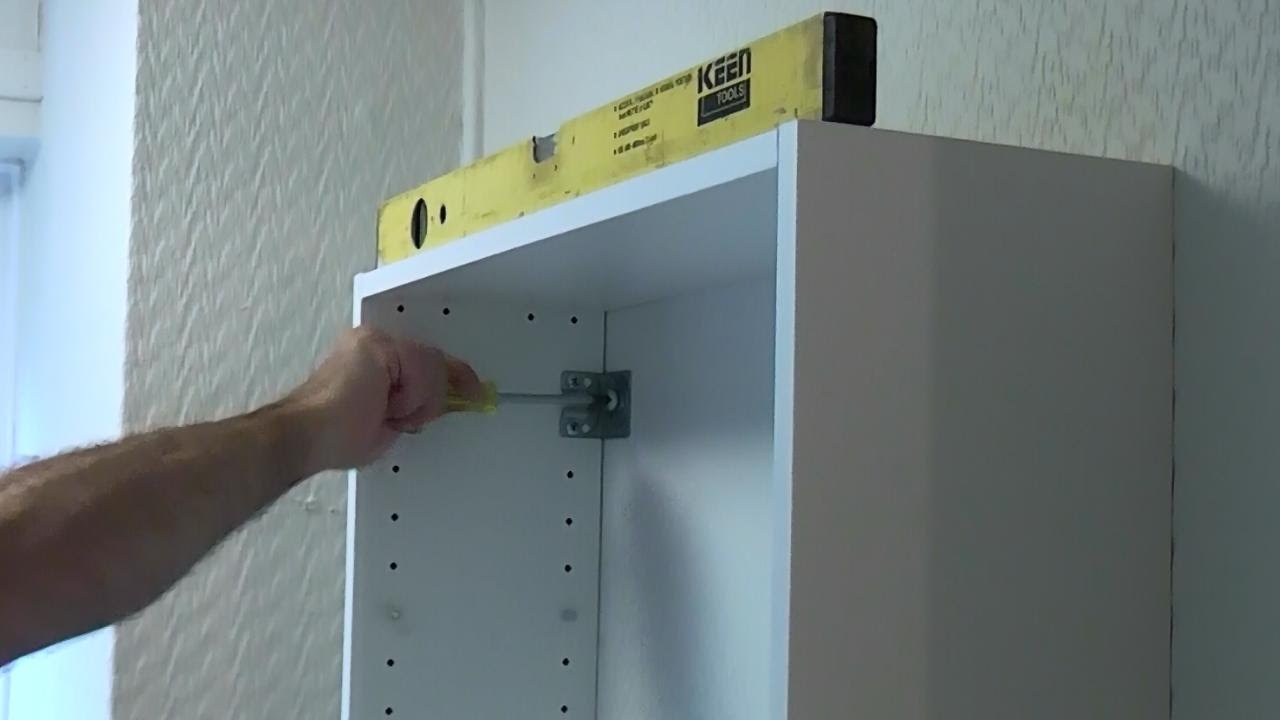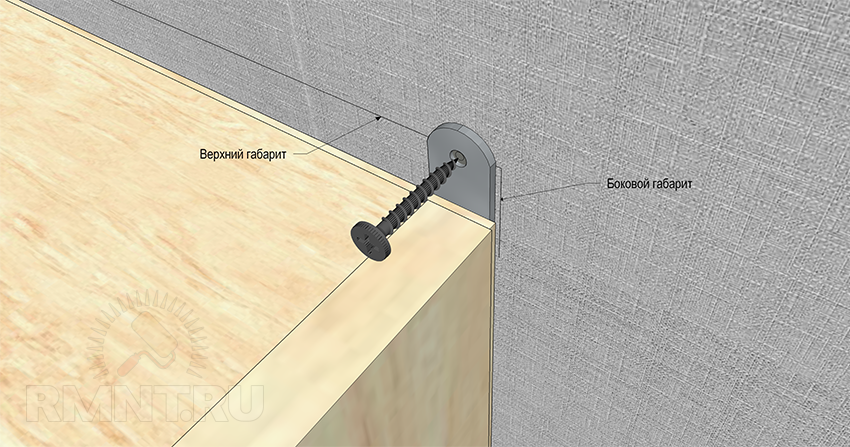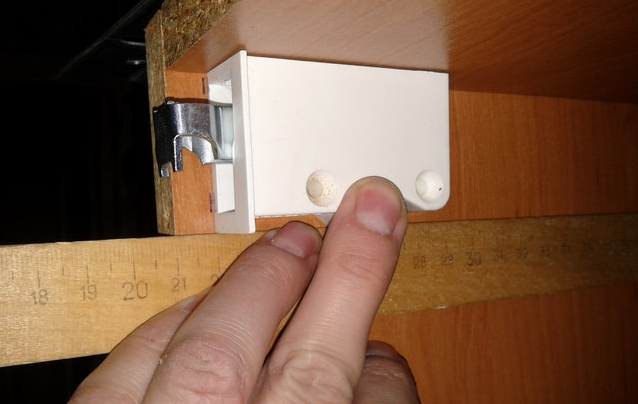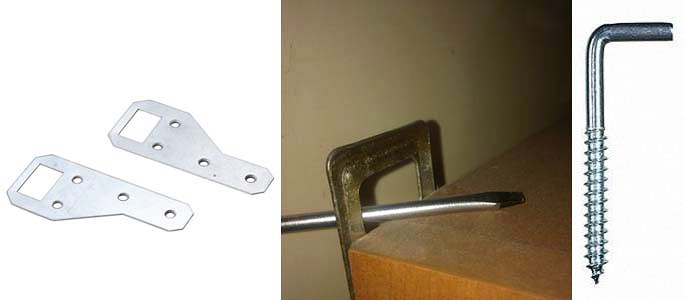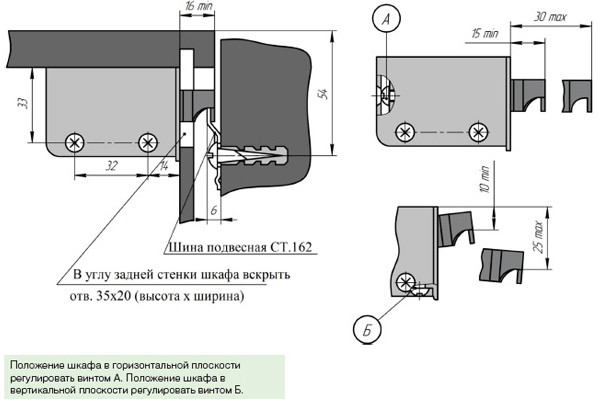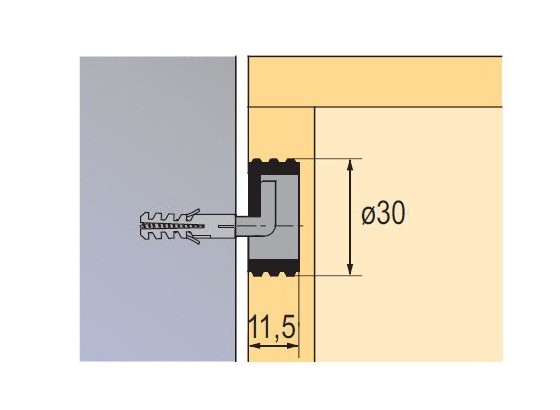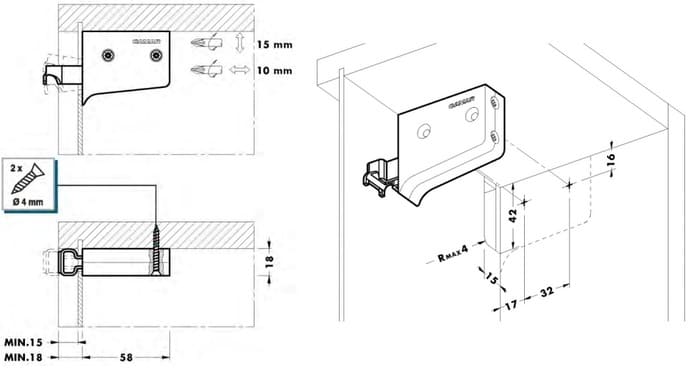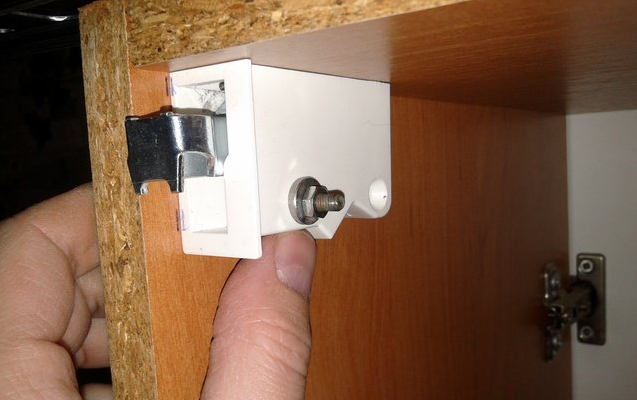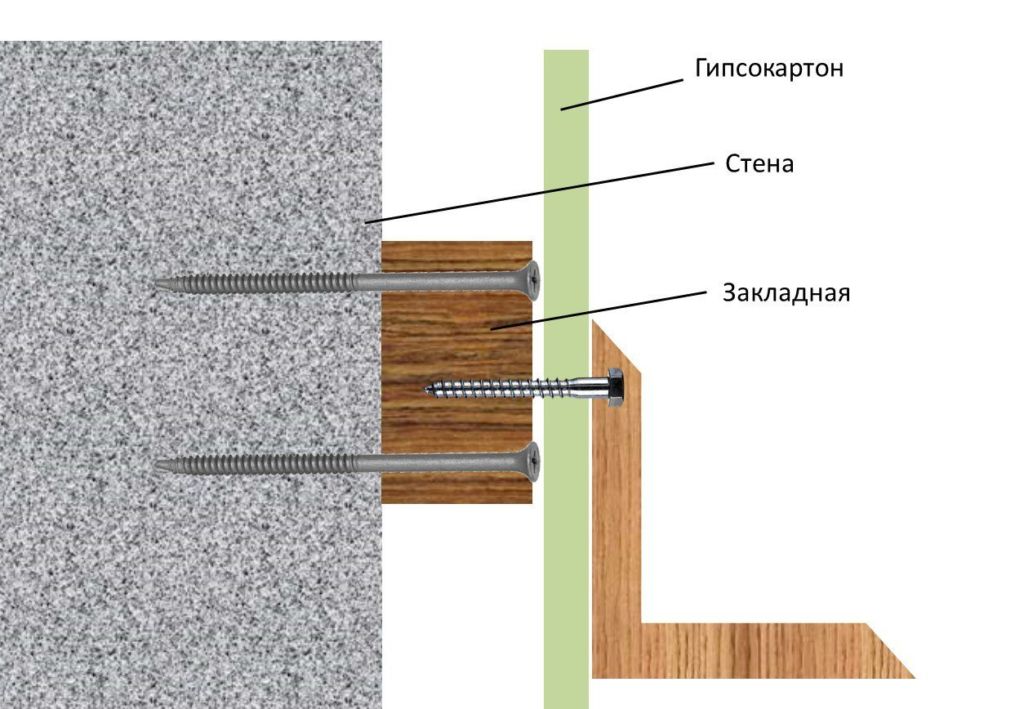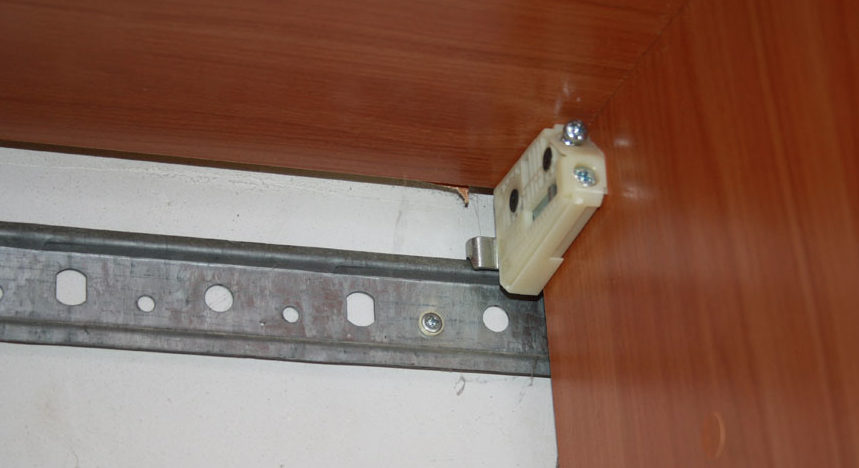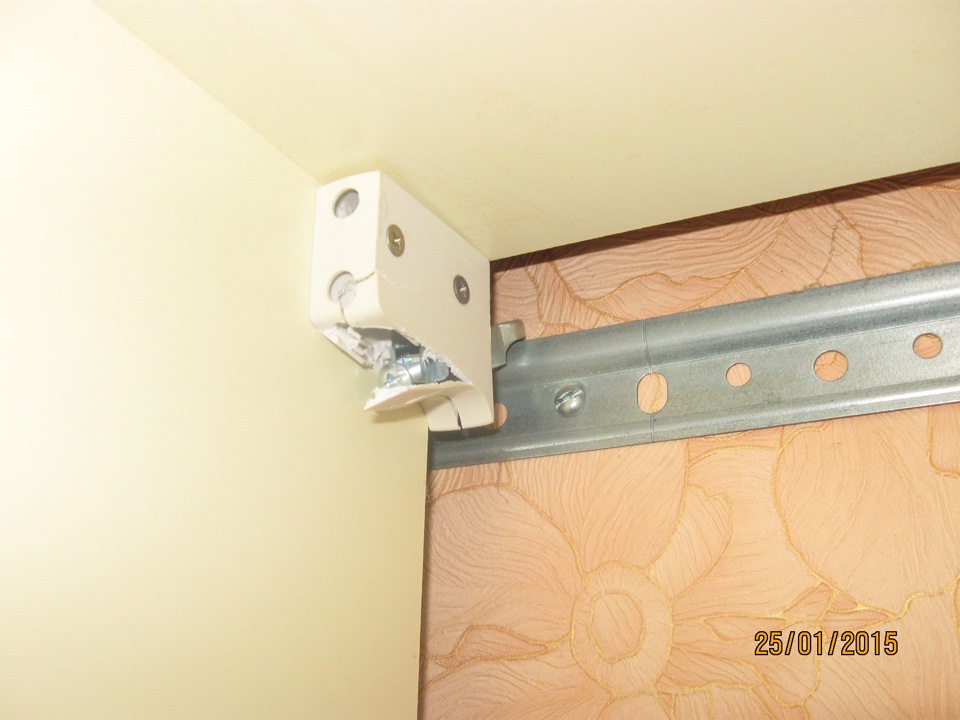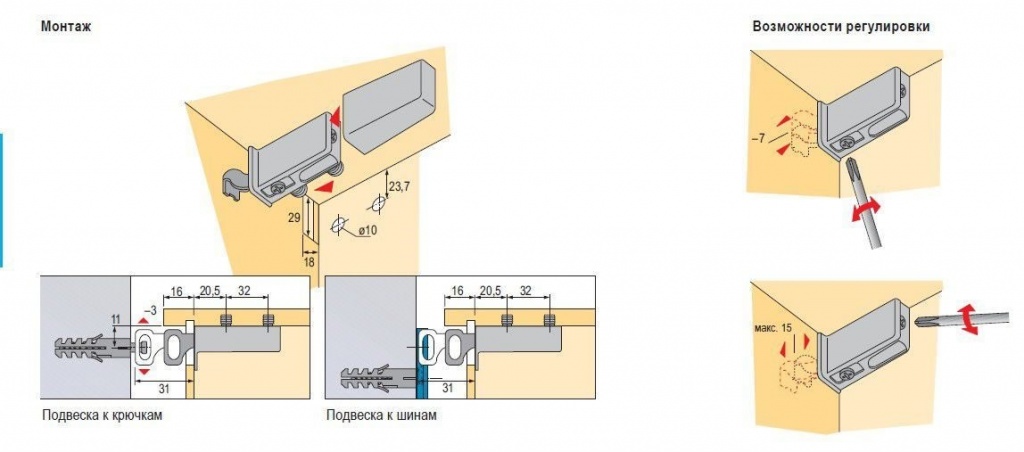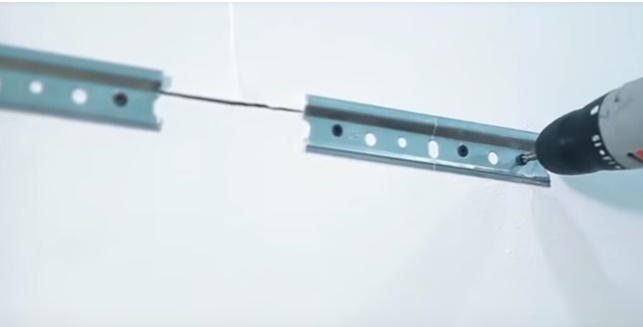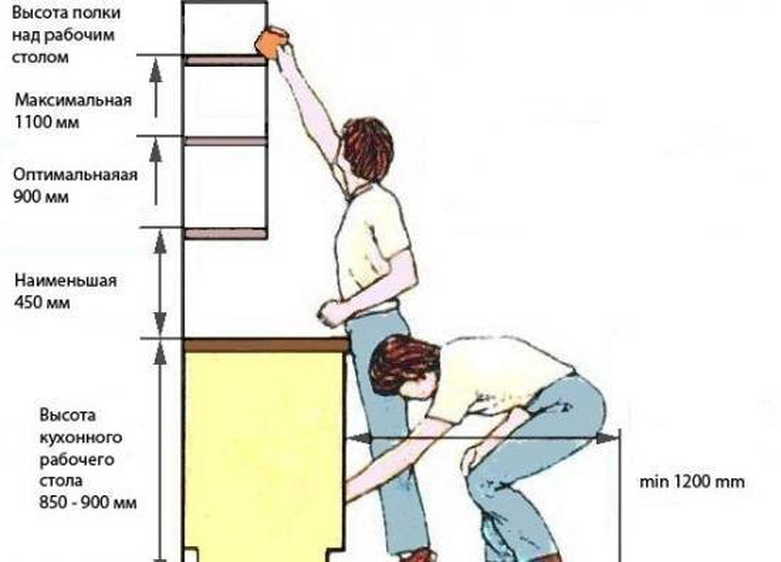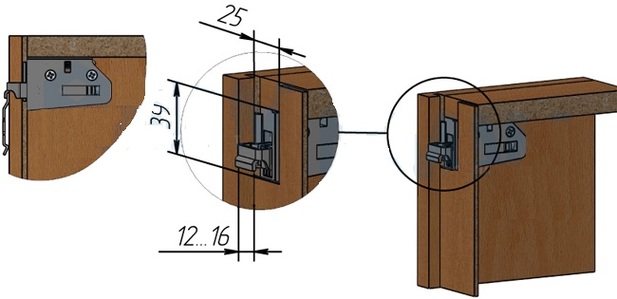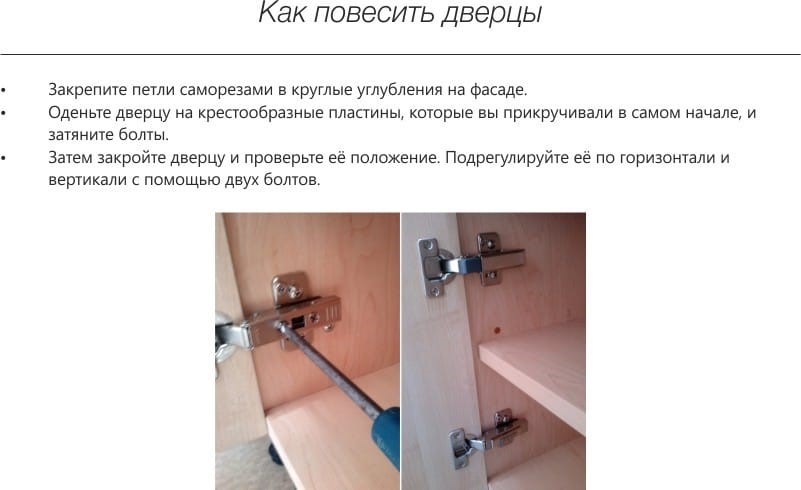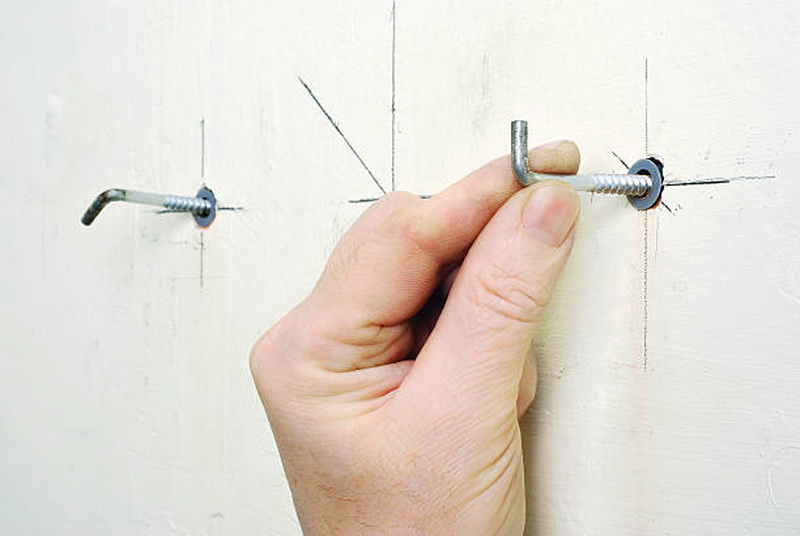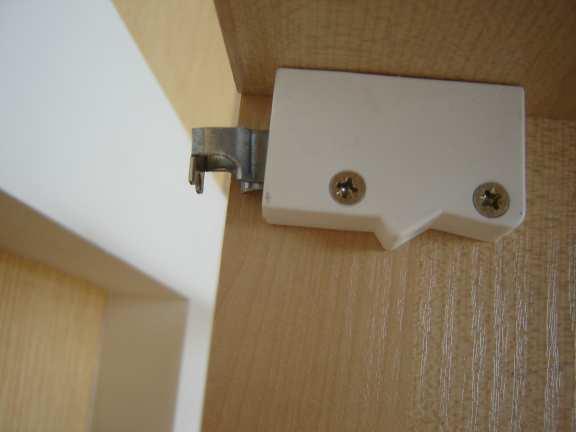Mounting methods
The use of dowels is the easiest way to install cabinets on structures made of different materials. In the old days, corners were used for this purpose. Today this method has lost its relevance. It was replaced by a mounting rail. If the question of how to hang a kitchen cabinet on the wall is being decided, a specific device called a hinge is also considered.
Mounting rail
The use of such fasteners improves the reliability of the structure. The lockers are hung on a horizontally oriented strip called a mounting rail. It has several holes. The main task is to mount this element on the wall. All that remains is to fix the cabinets with screws. The advantage of this solution is that there is no need for regular use of the building level in order to control the position of the pieces of furniture.
The use of self-tapping screws for the spot installation of individual cabinets does not provide a long service life. If you fix the furniture with a mounting rail, you can not only quickly mount the headset, but also get a structure that will be used for a long period. However, to keep the cabinets level, you will need to carefully check the position of the mounting rail.
Hinges
This type of fastener allows you to adjust the position of pieces of furniture in the horizontal plane. Installation instructions:
- A cabinet is placed between the previously marked marking lines. Hold it to mark the points for installing the dowel.
- A hole is drilled in accordance with the marking.
- Then you need to take the cabinet again and hold it in its original position (between the lines on the wall). The point of the second fastener is marked. You should first check whether the product is level.
- Install hangers for kitchen cabinets. After that, you can fix the product on the wall.
Plasterboard wall hanging
If you try to fix a fairly heavy structure on an unreliable partition, the furniture can collapse after a while. To avoid this, in the case when it is necessary to hang cabinets on a plasterboard wall, they consider the only option - fastening to a bar, which is an element of the partition structure. This transfers the weight of the upper part of the headset to the most reliable area made of metal. Fixing pieces of furniture is carried out using special dowels.
If the question of how to properly hang kitchen cabinets is being decided, you should follow the instructions:
- A magnet is used to search for fasteners in a drywall sheet.
- Correlate the distance between the nearest screws inside the partition structure and the size that determines the location of the hinges on the cabinets. If necessary, an intermediate bar is used for fastening. This method will redistribute the load on the entire partition.
- Heavy furniture is fixed on the gypsum board wall using anchors, long screws. The partition is drilled through to reach the supporting structure.
Useful aids for drilling
Many home craftsmen faced the problem of the drill offset from the intended point due to the heterogeneity of the walls. This leads to the fact that the exact horizontal of the line is lost and it is not possible to hang the shelf or other piece of the kitchen interior evenly.
In such a situation, craftsmen recommend independently preparing a plywood sheet with a hole (conductor) through which drilling will be carried out.So that when it is applied to the wall, it does not move during the operation of the drill, double-sided tape or sandpaper is glued to the surface oriented to the drilled plane. For versatility, several holes of different diameters can be made. If you equip one edge with a plate attached at a right angle, then the dust will not fly away, but almost all will settle on this shelf.
In order to secure cabinets, it is often necessary to prepare holes with a specific distance. Here, a conductor will also come to the rescue, on which an accurate marking is made, and two holes are being prepared. Further actions will be aimed at drilling the first socket for the dowel in the wall, in which one side of the conductor is attached with a self-tapping screw. It remains to level it using a building level and drill a second hole.
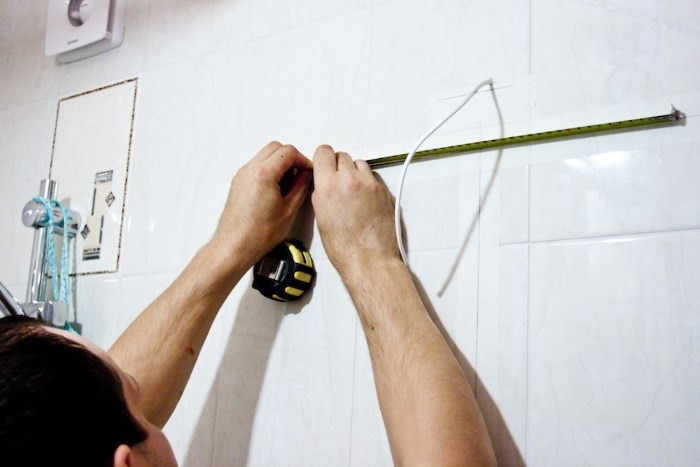
Method 3. Plastic and metal screw dowels
This is the fastest option for hanging a cabinet to a plasterboard wall. The downside is a significant limitation on the maximum load. The video below shows what kind of load different types of dowels can withstand:
For fastening, special screw-in dowels for DRIVA gypsum boards are used. They come in metal and plastic, with and without a drilling tip, have a large external thread and a cross slot for screwing into drywall with a screwdriver. In contrast to the previous methods, these fasteners should not get into the profiles of the metal frame.
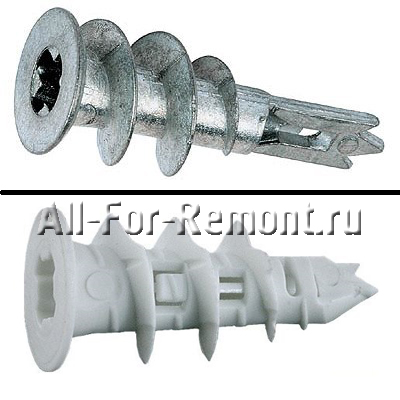
DRIVA is simply screwed into the plasterboard in the right place, its end is flush with the plane of the wall. It is necessary to control the effort during screwing so that the dowel does not "fall" through the gypsum board. Self-tapping screws or screws are screwed into the DRIVA to fix the hanging furniture.
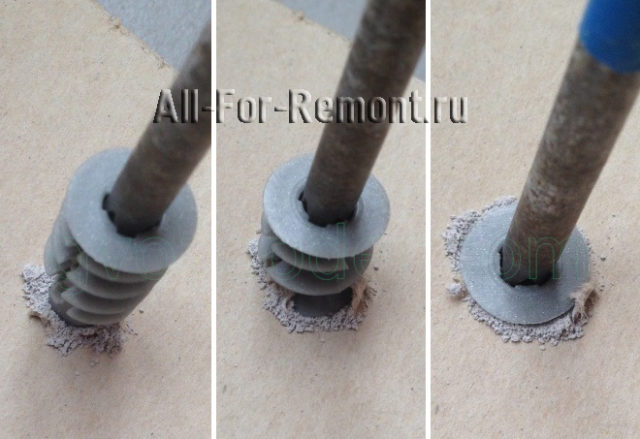
The stated maximum load on DRIVA fasteners is 25kg. At the same time, one should not forget about additional dynamic loads arising during operation. Craftsmen recommend using DRIVA for attaching small cabinets, shelves, plasma panels and paintings to drywall.
Another innovative solution is the use of the Fischer DuoTec self-aligning dowel. The principle of its operation and installation technique can be seen in the video:
Other types of fasteners
To hang several rather heavy cabinets on self-tapping screws already screwed into the wall, you can fix a bar on their back surface. This flat piece has a keyhole-like slot. It is selected so that the diameter of the widest part of the hole is slightly larger than the head of the self-tapping screw. The size of the narrow part of the hole should be slightly larger than the thread diameter. When hanging the cabinet, the head of the self-tapping screw enters the wide part of the slot, and then moves under the weight into a narrow area, ensuring reliable fastening.
If you need to fix a rather heavy object on the wall, made with plasterboard lining, then you can first make a hole with a diameter of ≈ 3 cm in the area of the fastener room, through which a solution is introduced into the empty space, allowing you to create a strong bridge to the wall.
You can simplify the process if you correctly calculate the length of the screw. In order for the kitchen wall cabinet to be firmly fixed, several quantities add up: the thickness of the drywall, the gap from the finish to the wall, the layer of plaster, the depth of the hole in the wall itself.
Wall preparation rules

Before installation, the working surfaces (rough) are put in order. The most important points:
- The walls are checked for distortions. In this case, you should use a level, a building level of great length.
- Assess the condition of the corner sections. The walls here should be at an angle of 90 ° C.
- Mounting sockets, chamfering rough surfaces - these steps are completed before the process of fixing kitchen cabinets to the wall begins.The same should be the approach to the distribution of water supply lines and sewerage systems.
- Finishing work in progress. Cabinets in the kitchen are installed after the end of the wall cladding, otherwise the joints between the pieces of furniture and the finishing material will be visible.
If the walls are undulating, it is advisable to remove the old plaster layer down to the brick / concrete. Then the partition is finished from scratch. In the case when cabinets are hung on undulating surfaces, without eliminating defects, the furniture will be uneven. This will negatively affect the interior.
Method number 1: on a wooden beam
In cases where you install plasterboard partitions yourself, you can mark your future kitchen in advance and lay a wooden beam in the place where the mounting rail passes before finishing work. Choose a beam of medium width, about 8-10 centimeters, so that later you can slightly adjust the height of the cabinets. The beam is laid in the intervals between the vertical guide profile to a width equal to the width of the kitchen set, and is attached to the main wall of the room. Subsequently, choose the fasteners for your cabinet in such a way that its length is sufficient for through-stitching the drywall sheet and fixing it in a wooden block. This method is usually chosen in cases where the main walls are leveled with sheets of drywall.

4 Suspension design features - how it works
As a rule, these furniture fittings have a decorative plastic case, inside which an adjustment mechanism is hidden. Outside, you can see only the heads of the adjusting screws, in addition, there are through holes in the case, reinforced inside with metal plates that enter the suspension mechanism block. However, some models are made entirely of metal, which makes them more durable and, accordingly, more expensive. And with any external differences, the design always includes the main part with which the cabinets are hung - a bar with hooks at the end, connected inside the case with adjusting screws.
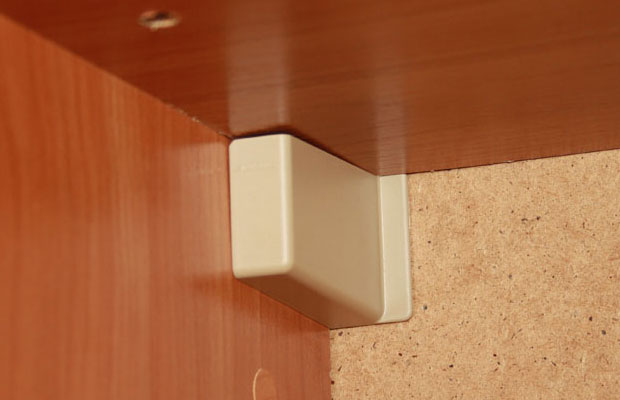
The suspension is usually a plastic case with an adjustment mechanism inside.
The movable mechanism gives the suspension some freedom of movement of the latch bar back and forth and up and down, with the main amplitude along the second vector being at the end with the hooks. Thus, by rotating the screws, you can push the suspension out of the case by 2 centimeters, and vertically adjust the height of the cabinet box within 22 millimeters. This is more than enough to ignore some of the unevenness of the wall and at the same time get the perfect line of position to hang each cabinet evenly on the kitchen wall relative to the neighboring ones.
Useful aids for drilling
A jack of all trades always needs certain tools to work in a private house, in a summer cottage, in an apartment, or when building his own house. Many of them are not even worth buying if they do not require constant use. For example, for drilling, there are many different attachments that will greatly enhance the function of your drill and significantly expand it.

Consider some devices for auxiliary potential.
To obtain accurate holes of significant size in diameter in different workpieces, a device such as a drilling and milling nozzle will help to do separate milling work.

Turn the drill into a milling machine.
The next device worth mentioning is very expensive, but it has the highest versatility. All the tools that you have on the farm, be it knives, shovels, axes, hoes, various drills, you will sharpen playfully with a universal sharpener.
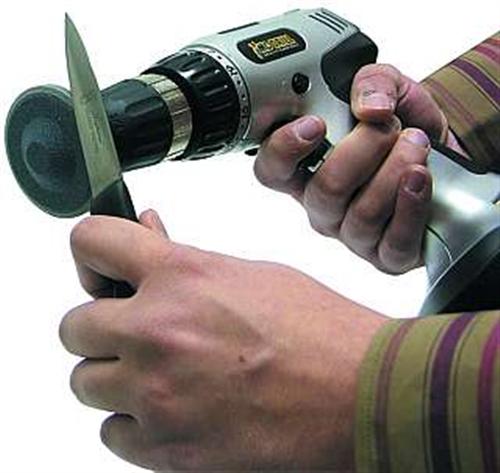
When buying a drill bit, be sure to check their compatibility.
Holder with clamp.With it, you can fix the drill anywhere, use it with all sorts of attachments, use it as a mini-lathe, sharpener, milling or grinding and polishing machine.

The drill holder provides a quick fixation of the drill.
Also for drills are all kinds of attachments. These can be stops that limit the drilling depth, platforms with which you can drill at a certain angle or perpendicular. There are nozzles, which are adapters and extensions of various designs: offset, angled, flexible.

The Angle Drill Adapter is designed for hand and power drills.
Metal cutting attachments transform your drill into a one-of-a-kind tool. Some resemble sheet metal shears, while others have a different feature, such as roller shears. The nozzle, called "Cricket", cuts through the metal, as it were.

The main advantage is that they do not damage the polymer coating of the metal.
There are also other attachments designed for one-type work.
- For installing aluminum rivets. There are types both for the same size, and with replaceable bushings for different calibers.
-
Self-tapping tape attachment. With its help, you will significantly save time when working with plasterboard partitions or when you need to fix other materials on self-tapping screws.
- A belt sander will completely replace a sander, and it will be much cheaper in cost.
-
The nozzle will not be superfluous, with the help of which you turn your drill into a hammer drill.
- Using the “angle pruner” attachment, you can cut various cables as well as tree branches.
- Using a variety of attachments, the drill will replace your jigsaw, circular saw, pump, you will be able to polish surfaces, sharpen drills.
-
There are unusual attachments.
Whatever attachments we use, the main thing is that the work is enjoyable.
Mounting options
There are 2 methods for fixing kitchen cabinets. Installation is carried out:
- One line, that is, the location of the fastener is equidistant from the ceiling;
It is considered the most common type of accommodation. Thus, you can easily fix the cabinets yourself.
This method is used much less often, since its implementation is much more complicated than a linear fastening scheme.
The first method is popular because you can only use your own strength to fix kitchen cabinets without asking outside help.
The choice of option is determined by the number, size and depth of the wall cabinets.
The second option for attaching fixation items is less common among ordinary people. This is because the roof of this furniture is used as an additional surface.
Any of the proposed variations is perfect for both a small area and a large one.
And all due to the fact that they do not have any effect on the fullness or compactness of the room.
When choosing a method, only the interior and design change.
Hang cabinets on drywall
Often, apartment owners have to decide how to hang the kitchen on drywall.
As you know, such a material is not durable, but we need guarantees of high-quality installation - who wants to see some cabinet ever collapse on the floor?
The problem is still doable.
Fastening methods:
- Dowel-butterfly. Suitable only for lightweight add-on modules weighing up to 5 kg. The dowel body is aluminum, made in the form of a collet (hollow cylinder with longitudinal cuts). When the screw is screwed into the dowel, the antennae move apart and press into the surface of the hole in the sheet.
- Mounting rail. It is attached to a sheet and a wooden frame - this provides a higher reliability of fastening.Knowing in advance that the cabinets will be hung, it is necessary, if possible, to take care of a more solid foundation (mortgages) under the drywall in the form of a bar.
- In order to secure very bulky furniture, they also use additional fasteners: a decorative cable. It is attached to the ceiling. In addition, chrome-plated tubes are used. They are bolted to the floor and serve as a frame.
Advantages and disadvantages of the plank
This uncomplicated design has a number of advantages, thanks to which it gained its popularity:
- Even non-professionals - people with basic construction skills - can cope with the installation.
- When installing adjustable awnings, you do not need to measure and drill holes for each hanging wall cabinet separately. The general level is being fought back.
- The anchor bolts can be used to adjust the position of the cabinets. They can be put on the same level, regardless of the flaws in the wall.
- Unlike fastening for wall-mounted kitchen cabinets on dowels, the design with a strip is considered more "hardy" and reliable. Even if a couple of self-tapping screws weaken over time, the rest will hold well even the most full cabinets.
The system has no global shortcomings. The only thing worth watching when purchasing a bar is the quality of the material. Low-grade metal will bend a lot and may even break during furniture assembly.
 The fixing mechanisms of kitchen cabinets have to undergo heavy loads.
The fixing mechanisms of kitchen cabinets have to undergo heavy loads.
Bolts, anchors or bars?
So that the fasteners are reliable, and the filled cabinet does not fall at the most unfortunate moment, the material for making the walls and furniture should be taken into account. Think carefully about the type of attachment.
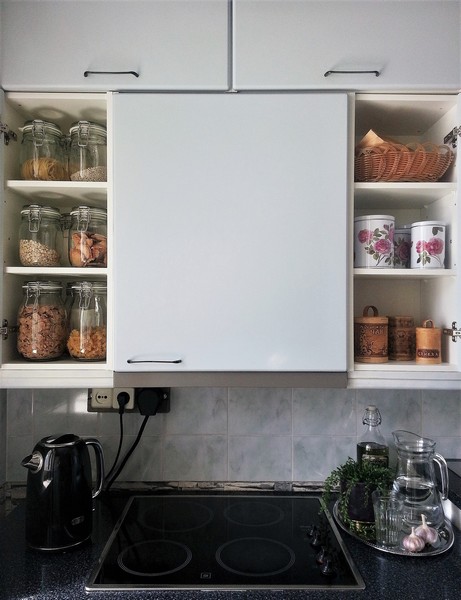
How to fix and what fittings are most optimal for a brick, concrete, wooden wall?
For a wooden wall of a country house, fasteners using hardened alloy countersunk head screws will be optimal. The most effective installation is with self-tapping screws with a large pitch and two-start thread.

It is better to fasten the shelves to a concrete and brick base with dowels, plugs, metal bolts, plastic fasteners. You can strengthen the fittings in the holes after the drill with plaster mortar.
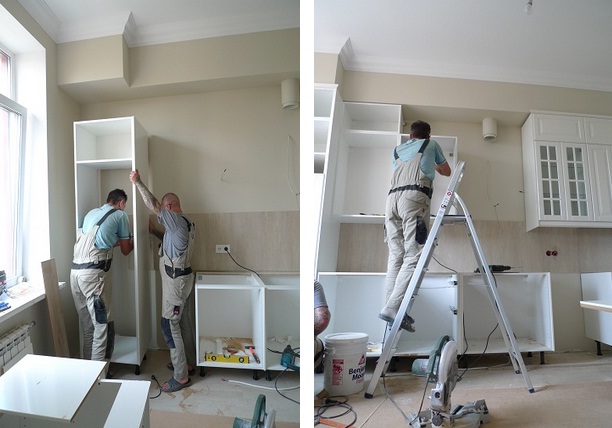
Molly's screws or butterflies will securely secure the hanging furniture to the plasterboard wall.
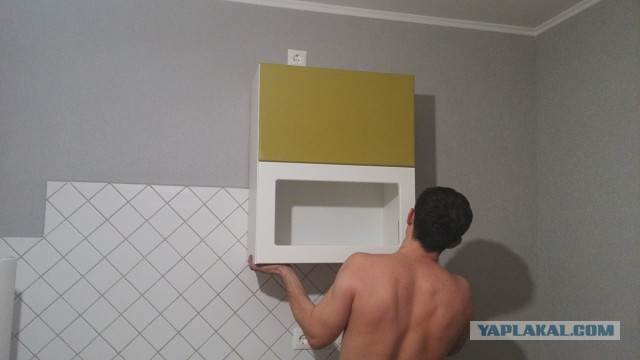
For open shelves with a small load, decor, lighting, you can use plastic butterfly dowels and drill dowels.

Hanging storage systems for dishes, products, appliances should be mounted on classic metal fittings. For example, you can buy ordinary dowels made of durable alloy or molly (butterfly dowel in metal version).

If it is impossible to reach the wall through the cladding, you can use wooden bookmark blocks. The thickness of the embedded beam must be equal to the thickness of the transverse frame. If these numbers do not match, the structure may deform. The adjustment of the thickness of the timber is performed according to the profile sample. As a fastening hardware, a metal butterfly screw is optimal.

The attachment of the attached object is made directly to the bar from the bars. To enhance the bearing capacity, use the greatest length of the strip: for example, across the width of the entire set of hanging furniture.
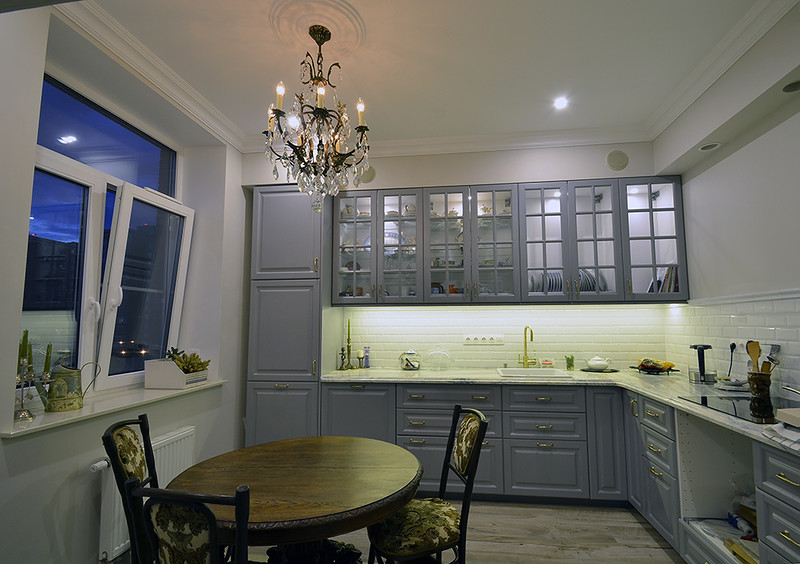
The most proven are two types of fasteners:
- mounting rail;
- classic bolts and screws.
Installation method
In order to properly fix the kitchen wall cabinets, you need to select the tool in advance and strictly follow the installation technology. It is easier to do work in 4 hands, but 1 person can handle it too
Of course, it will take a little more time, it will require the utmost concentration of attention, accuracy and caution.
 An important factor is the reliability and quality of fastening each part of the headset to the wall.
An important factor is the reliability and quality of fastening each part of the headset to the wall.
Preparatory stage
Before starting the process of drilling surfaces and directly mounting, you need to perform the following actions:
-
Cleaning and leveling the walls. The easiest way to do this is with drywall.Previously, a frame of profiles must be fixed on the wall, on which the structure of the cabinets will be held.
-
For corner kitchens, the mating angle of the two planes should be kept at 90 degrees. If the curvature of the walls is negligible, you can simply plaster them.
-
Drawing basic markings. Using a perpendicular, a construction pencil and a level, you need to schematically position the attachment points, select the height of the structure.
-
If the situation requires it, you must first perform the installation of all sockets and lighting fixtures, attach all related elements.
-
Before starting work on the installation of kitchen cabinets, the walls should be painted or covered with wallpaper - after installation, no repair work should be carried out.
Hanging heights
It should be convenient to use the headset, therefore, the height of the lockers directly depends on the height of the owners and the anatomical features of their figure, the characteristics of the room.
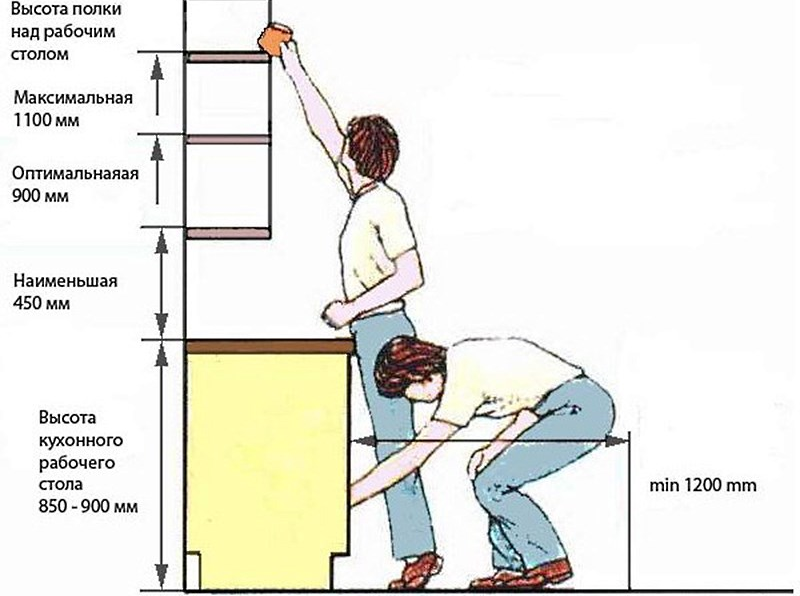 Before you start assembling the headset into a single "wall", you need to decide on the height at which the furniture will be hung.
Before you start assembling the headset into a single "wall", you need to decide on the height at which the furniture will be hung.
Main criteria and figures:
- The boxes should be tactile and located at eye level. On average, the distance from the plane of the tabletop to the upper cabinet is 55-65 cm. In this case, a person should reach the uppermost shelf without the risk of dropping the desired item and without using auxiliary items (chairs, benches, etc.).
- If you do not plan to mount a tabletop or the lower part of the headset, then the ratio of a person's height and the height of the fastener should look like this:
- up to 165 cm - 175-180 cm;
- 165-157 cm - 185 cm;
- 175-190 cm - 200 cm.
 To correctly perform these manipulations, preliminary calculations must be made.
To correctly perform these manipulations, preliminary calculations must be made.
Required tools and materials
For a quick and high-quality work, you will need:
- Drill or hammer drill with drills or drills. For bricks and concrete, impact mode should be used; for other surfaces, conventional drilling will suffice. When working with tiles, you need to stock up on drills with victorious solders.
- A screwdriver, by means of which self-tapping screws will be screwed to fasten the holders to the cabinets.
- Construction pencil and tape measure.
- Level for marking the location of the lockers and adjusting the awnings.
- Stable staircase.
Methods for assembling hinged elements
Any kitchen disassembled is a set of parts from chipboard and MDF, fittings, fasteners. Using all this, you need to assemble the cabinets. The kitchen is mainly equipped with upper and lower cabinets.
Methods for assembling a kitchen set:
- In pairs. The wizard assembles the upper and lower cabinet of the headset, and then installs this pair.
- First, the assembly of the upper cabinets, and then the lower ones.
- The lower elements are collected first, and then the upper ones. Many people find it more convenient to hang the top elements while standing on the countertop.
If you collect everything at once, and then install it, then you can clutter up the entire apartment, and sometimes this is not possible, especially if the apartment is one-room or is heavily crammed with furniture.
How to place it correctly?
There are a few simple rules:
- the availability of food, dishes and other kitchen utensils that are stored in the closet - in order to ensure this possibility, it is recommended to place pieces of furniture at a given distance from the tabletop, and not under the ceiling;
- cabinets should not interfere with air circulation, therefore they are installed next to the ventilation grill, while it is forbidden to close the entrance to the channel;
- pieces of furniture in the kitchen are positioned so that they do not spoil the geometry of the room.
The distance is sufficient to place all kitchen appliances on the table. Moreover, more often they choose an option within 45-50 cm. A distance of 65 cm and above in most cases determines the position of the hood (from the table top to its lower edge).
You should also focus on the growth of the residents of the house. Possible options:
- With a person's height in the range of 155-160 cm, the recommended height from the floor to the top shelf is 175 cm.
- If the height is 160-170 cm, the top shelf should be located at a height of 190 cm.
- For tall house owners (height 170-190 cm), an option is suitable when the upper shelf is at a height of 200 cm.
If you do not focus on these recommendations, it will be difficult to freely use the dishes and kitchen utensils located in the cabinets. We'll have to use a stool for this purpose. In addition, you need to check at the installation stage that the hanging furniture is level. Any distortions can lead to the collapse of part of the kitchen utensils. In this case, the appearance of the interior also deteriorates. Use a spirit level to check the position of the cabinets.
Almost always, hanging and floor pieces of furniture are positioned so that they are on top of each other. Otherwise, the headset will not look organic, the symmetry will be lost. If necessary, the cabinets are positioned above or below the existing standard values. However, before you finally drill the holes in the wall, make sure that a person can easily reach the top shelf. Recommendations for calculating the installation height of the cabinets:
determine the growth of all residents of the apartment, take the average value - if you focus only on 1 family member (the highest or the lowest), then the rest will be inconvenient to use the furniture; take into account the dimensions of the upper cabinets; the headset looks most harmonious, which occupies most of the wall, for this reason, when choosing, you need to focus on the height of the ceilings of the room; sometimes it is important to make the apron high enough (for example, when installing specific decorative elements, the upper cabinets are additionally raised); take into account the style direction in which the headset is made (sometimes it is necessary to place the cabinets at some distance from each other)
Installation instructions
- After completing the preparatory work, you can start assembling. After screwing in the screws, it is necessary to align the hooks in one position and make sure that they are at the middle level. The awnings must be fixed in one position. The protrusion of the fixing part (in a hook configuration) must be 2 mm in relation to the back of the wall.
- If it was planned to cut the tire, then it is worth tackling the blanks.
-
Holes are made on the pre-marked wall for fixing the tire.
- The hinged furniture body must be mounted on the rail. The reference point is the plane of the wall. The next fastening of wall-mounted kitchen cabinets is carried out, focusing on the previous one.
-
The next step is to sequentially fix the installation objects with fasteners. For this, a clamp is used. To prevent damage to the surface, a thin layer of insulating material must be laid.
- Next, you need to drill holes in the housings. To avoid cracks or splinters, use a plywood or wood cover. After preparation of the apertures, the elements are connected with ties.
-
After hanging and fixing the drawers, screw the doors. To do this, they must be laid out on the floor in such a way as to connect the hinges to special niches. After this procedure, it is mounted to the body.
Loose and hollow walls
It is quite difficult to rigidly fix fasteners to a wall made of foam blocks, shell rock, adobe and similar materials. The use of ordinary dowels or anchors does not allow achieving the desired effect for a long time, especially if the cabinet is heavy.
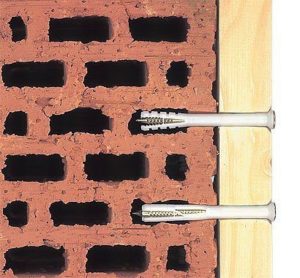 Expanding dowels
Expanding dowels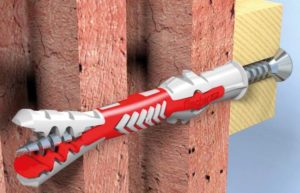 Fisher Intelligent Dowel
Fisher Intelligent Dowel
Depending on the material and the possible load, powerful screw or drop-down fasteners are used to hang the cabinets. In some cases, special dowels or long anchors (120-210 mm) are used.In old adobe buildings, hinged furniture used to be attached to long nails driven into the wall without any drilling.
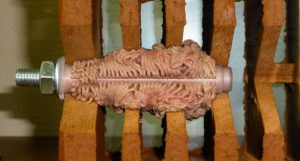 Hollow wall chemical anchor
Hollow wall chemical anchor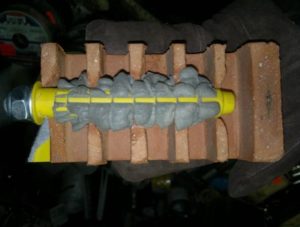 Special solution fills empty space
Special solution fills empty space
The load on fasteners in thin, loose walls can be reduced by partial transfer to the side elements of the kitchen, for example, on a bar pipe or a pencil case. Installing cabinets on a common hinged rail and tying them together will also help to evenly distribute the weight of the furniture.



